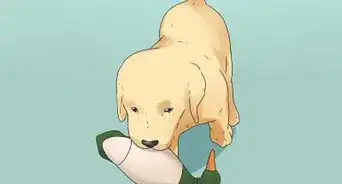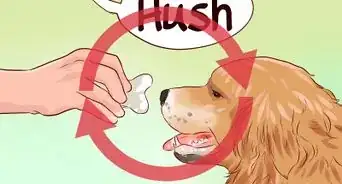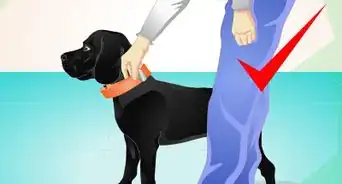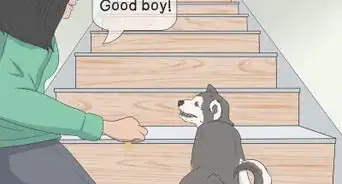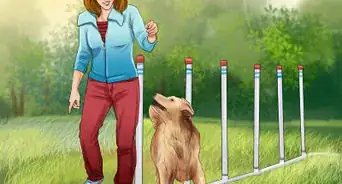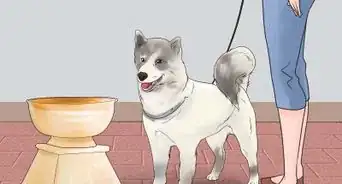This article was co-authored by Sophie Amphlett. Sophie Amphlett is a Professional Dog Trainer and Service Dog Coach with over five years of experience. Sophie graduated from CATCH Canine Trainers Academy’s Master Course with Distinction in 2016. She is also a Certified Trick Dog Instructor (CTDI) and a Certified Fun Scent Games Instructor (DN-FSG1). Sophie serves as a volunteer adoption counselor and dog walker for Adopt-A-Pet as well.
wikiHow marks an article as reader-approved once it receives enough positive feedback. This article received 21 testimonials and 84% of readers who voted found it helpful, earning it our reader-approved status.
This article has been viewed 720,620 times.
Clicker training is a popular way to train your dog and reward his good behavior. It can be fun for you and your dog and often produces quick and effective results.[1] Clicker training is based on the scientific concept that an animal will continue to do a behavior that is rewarded.[2] Once your dog understands what the clicker is all about, you will be able to teach him all kinds of tricks with plenty of rewards along the way.
Steps
Preparing to Clicker Train Your Dog
-
1Learn how to use a clicker. A clicker, which is available at your local pet store, is a small, handheld plastic device with a button or small metal tongue that you press down on to make a clicking noise. The key to using a clicker is to use it at the exact moment that your dog performs the expected behavior. The sound of a click should always be followed by some type of reward (eg, food, toys, verbal praise).[3] [4]
- Keep in mind that the clicker is the signal that a reward is coming, rather than being the reward itself.
- With the clicker, your dog will learn two main things–the exact moment that he is doing the right thing, and that a treat always comes after the click.
- The clicker can be a much more precise method than verbal cues ("good" or "thanks") to communicate with your dog during a training session. This can help speed up the pace of training.[5]
- You could think of the clicker like the winning buzzer on a game show–the noise signals the exact moment that the correct behavior or action is being performed.
EXPERT TIPDr. Elliott, BVMS, MRCVS is a veterinarian with over 30 years of experience in veterinary surgery and companion animal practice. She graduated from the University of Glasgow in 1987 with a degree in veterinary medicine and surgery. She has worked at the same animal clinic in her hometown for over 20 years.Veterinarian
 Pippa Elliott, MRCVS
Pippa Elliott, MRCVS
VeterinarianPippa Elliott, a licensed veterinarian, advises: "We use a clicker because it has a distinct sound, unlike anything else the dog hears. But you can use any noise, so long as it's consistent; for example, the click of a ballpoint pen retracting or a click with your tongue."
-
2Introduce your dog to the clicker. Before you can use the clicker for training purposes, you will need to teach your dog what the clicker means to him. This is known as “charging” the clicker.[6] While you are in the room with your dog (any quiet room will do), hold a treat in one hand and the clicker in the other. Press down on the clicker once. When your dog turns to you at the sound of the click, immediately give him the treat.
- You will need at least a handful of treats, since you will be practicing this over and over.
- Repeat this several times. Vary the amount of time that you hold the treat in your hand before using the clicker so that your dog does not begin to expect when the treat will come.
- If your dog wants to sniff and try to get at the treat, keep your hand closed and wait until he loses interest in the treat before using the clicker.
Advertisement -
3Observe your dog’s response to the clicker. Some dogs may be sensitive to the sound of the clicker. If your dog runs away when he hears the clicker, the sound is probably a little too harsh for him. To soften the sound, you could wrap a towel around the clicker. You could also use a different clicking device, such as a ballpoint pen, that would have a quieter clicking sound.
- If he continues to run away from the clicking noise, you will probably need to rely more on verbal cues to train him.
Training Your Dog With a Clicker
-
1Choose a quiet location. Once your dog has learned what to expect with the sound of the clicker, you can use it to train him to do different commands (e.g., sit, down, stay). It would be best to train him in a quiet location without other people or distractions around.[7] If you have a fenced in backyard, you could also clicker train him outside.
- As your dog becomes more comfortable with clicker training, you can use the clicker in areas that are louder or have more distractions (e.g., room with a TV on, dog park).
-
2Click when your dog is in the act of good behavior. One method of clicker training your dog is called “catching”– you will click as soon as you catch your dog doing a good behavior that he’s already pretty good at doing on his own. For example, if he is in the room with you and decides to lie down to get more comfortable, click as soon as he lies down and immediately throw him a treat. When he gets up to eat the treat, wait until he lies down again and repeat the process.
- The “catching” method will only work when your dog already knows how to do the good behavior without being commanded to do so.
- The clicker training will reinforce to him that he is doing the right thing, which will encourage him to repeat the good behavior.
-
3Use the clicker at each small step of a new behavior. This is called “shaping”– by using the clicker and immediate reward at each small step, you are shaping the new behavior as a whole. For example, if you want to train your dog to go lie down in a specific area, click and reward him as soon as he turns his body in the direction of that area. You can then click and reward him at each small step: beginning to walk to the new spot, arriving at the new spot, starting to lie down, and fully lying down on the floor.
- By using the clicker and reward at each small step, you will be providing him with continual positive reinforcement as he is learning the new behavior. He will think that this learning is fun and will likely perform the new behavior with eagerness.
- You may need to practice each step of the new behavior over and over again before moving to the next small step.
-
4Use a food lure. For this method, the treat is used to lure your dog into doing the expected behavior. A food lure is commonly used when training a dog to lie down. For this behavior, you would hold the treat right in front of your dog’s nose and slowly move the treat down to the floor. Your dog will follow the treat down. When his elbows hit the floor, immediately click and reward him with the treat.
- When you see that your dog consistently responds with the food lure, remove the food lure but continue to hold your hand in front of his nose as if you have a treat. When he lies down, immediately use the clicker and give him a treat.
- Eventually, your dog will learn how to lie down by following only your hand signals without the lure of a treat.
- The “lure” method can sometimes be quicker than the “shaping” or “catching” methods.
-
5Add a verbal cue. Adding a verbal cue is helpful regardless of which method of clicker training you have been using to train your dog. You will say the cue first and then wait for your dog to do the desired behavior. As soon as he does the behavior, click and reward him with a treat.[8]
- Your verbal cue should be short and direct, such as "sit" or "down." Sentences, such as "Be a good boy and stay" or "Roll over for mommy" would be too long.
- Make sure that you give the verbal cue before your dog does the behavior so that he knows to listen for your command and then respond to it.
- If you have used the “lure” method, give the hand signal after saying the verbal cue.
Expert Q&A
-
QuestionHow do I teach my dog to sit using a clicker?
 Sophie AmphlettSophie Amphlett is a Professional Dog Trainer and Service Dog Coach with over five years of experience. Sophie graduated from CATCH Canine Trainers Academy’s Master Course with Distinction in 2016. She is also a Certified Trick Dog Instructor (CTDI) and a Certified Fun Scent Games Instructor (DN-FSG1). Sophie serves as a volunteer adoption counselor and dog walker for Adopt-A-Pet as well.
Sophie AmphlettSophie Amphlett is a Professional Dog Trainer and Service Dog Coach with over five years of experience. Sophie graduated from CATCH Canine Trainers Academy’s Master Course with Distinction in 2016. She is also a Certified Trick Dog Instructor (CTDI) and a Certified Fun Scent Games Instructor (DN-FSG1). Sophie serves as a volunteer adoption counselor and dog walker for Adopt-A-Pet as well.
Professional Dog Trainer When I'm teaching a dog to sit, I use a hand signal where my palm is out and my forearms are at a right angle. I lift my hand up above the dog's nose with a treat in it. As you lift the food above the dog's nose, their nose is going to go up and their butt is going to go down. The second their butt touches the ground, I click with the clicker to mark that precise moment and give them the treat. Once the dog is proficient at the hand signal, you then would say a cue word, like "sit," a fraction of a second before you do the hand signal. Then you would start gradually fading out the hand signal.
When I'm teaching a dog to sit, I use a hand signal where my palm is out and my forearms are at a right angle. I lift my hand up above the dog's nose with a treat in it. As you lift the food above the dog's nose, their nose is going to go up and their butt is going to go down. The second their butt touches the ground, I click with the clicker to mark that precise moment and give them the treat. Once the dog is proficient at the hand signal, you then would say a cue word, like "sit," a fraction of a second before you do the hand signal. Then you would start gradually fading out the hand signal. -
QuestionCan you use a clicker with a shy dog?
 Sophie AmphlettSophie Amphlett is a Professional Dog Trainer and Service Dog Coach with over five years of experience. Sophie graduated from CATCH Canine Trainers Academy’s Master Course with Distinction in 2016. She is also a Certified Trick Dog Instructor (CTDI) and a Certified Fun Scent Games Instructor (DN-FSG1). Sophie serves as a volunteer adoption counselor and dog walker for Adopt-A-Pet as well.
Sophie AmphlettSophie Amphlett is a Professional Dog Trainer and Service Dog Coach with over five years of experience. Sophie graduated from CATCH Canine Trainers Academy’s Master Course with Distinction in 2016. She is also a Certified Trick Dog Instructor (CTDI) and a Certified Fun Scent Games Instructor (DN-FSG1). Sophie serves as a volunteer adoption counselor and dog walker for Adopt-A-Pet as well.
Professional Dog Trainer Yes, but you want to be mindful if the dog is noise-sensitive. Some clickers are quite loud. You can muffle the sound by wrapping the clicker in your sleeve, or you can buy a quiet clicker to use instead.
Yes, but you want to be mindful if the dog is noise-sensitive. Some clickers are quite loud. You can muffle the sound by wrapping the clicker in your sleeve, or you can buy a quiet clicker to use instead.
References
- ↑ http://www.petplace.com/article/dogs/behavior-training/training-your-dog/clicker-training-your-dog
- ↑ http://www.akc.org/learn/akc-training/what-is-clicker-training-a-great-way-to-shape-your-dogs-behavior/
- ↑ http://www.akc.org/learn/akc-training/what-is-clicker-training-a-great-way-to-shape-your-dogs-behavior/
- ↑ Sophie Amphlett. Professional Dog Trainer. Expert Interview. 30 December 2020.
- ↑ http://www.akc.org/learn/akc-training/what-is-clicker-training-a-great-way-to-shape-your-dogs-behavior/
- ↑ http://www.akc.org/learn/akc-training/what-is-clicker-training-a-great-way-to-shape-your-dogs-behavior/
- ↑ http://www.petplace.com/article/dogs/behavior-training/training-your-dog/clicker-training-your-dog
- ↑ Sophie Amphlett. Professional Dog Trainer. Expert Interview. 30 December 2020.
About This Article
To start clicker training your dog, use your clicker and a treat every time you catch your dog doing something good to associate the noise with positive behaviors. For example, if your dog lies down quietly, click immediately and give a treat. You can also use the clicker to reinforce verbal cues. For example, give the verbal cue for your dog to "sit," and as soon as your dog performs the desired action, click and reward with a treat. For advice from our Veterinary reviewer on how to shape new behavior, keep reading!




